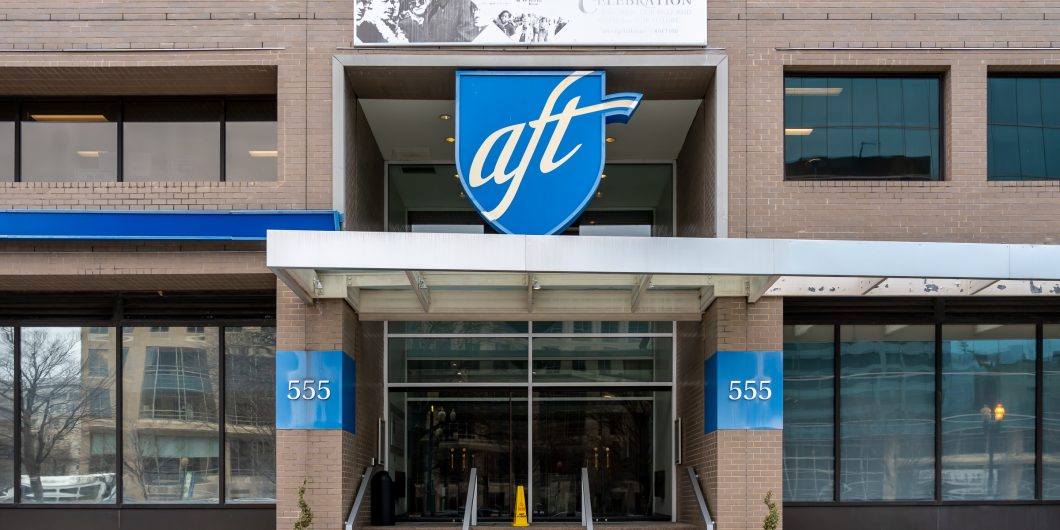UK Labour appears to be unwilling to confront anti-Semitism in its ranks.
For Whom Does the Union Speak?
In May 2021, when James Davis became president of the union representing 30,000 faculty and staff at the City University of New York (CUNY), it was a time of budget cuts that roiled union members. The year before, in the midst of the COVID-19 pandemic, the union complained but was unable to do much to stop the university system from cutting 2,800 part-time and hundreds of full-time positions.
Perhaps this helps explains why Davis agreed to engage in some performative activism just a month into his term as union president. In June 2021, his union, the Professional Staff Congress (PSC), passed a resolution condemning Israel for violence against the Palestinian people during a conflict that erupted in May. The resolution calls Israel a “settler colonial state” guilty of “apartheid” and “legalized racial discrimination.” It also recommends the union explore the possibility of becoming part of the anti-Israel BDS movement.
The PSC was just one in a herd of unions that chose to take the anti-Israel position. Roofers Local 36 in Los Angeles released a statement condemning Israel, while UNITE HERE Local 23 representing hospitality workers in the South tweeted out their support for Palestinians, as did the Teamsters Local 804 in New York City.
What set PSC apart was the swift backlash to the resolution by the union’s members. Within weeks, at least 100 professors pledged to resign, potentially costing the union around $100,000 a year in dues.
Taking on a Hostile Union
Among those professors was Avraham Goldstein, a CUNY math professor and Orthodox Jew. For Goldstein, the PSC’s resolution read like a personal attack on him and his family. In a Wall Street Journal op-ed headlined “I’m Stuck With an Anti-Semitic Labor Union,” Goldstein explained that his family moved to Israel from the Soviet Union to escape the anti-Semitism there. He later moved to the United States to work as a professor, only to find that his union was now working against his deepest beliefs.
Goldstein is now party to a fascinating lawsuit, suing for the constitutional right to completely disassociate from the union and reject its representation of him. As he explained in the same op-ed, such a lawsuit is necessary due to a feature of modern labor law:
Under New York law, even if I resign from the union, I will never be free to bargain or speak for myself when it comes to matters of my employment as a CUNY professor. I am forced to rely on a union that says anti-Semitic, hateful things about Israel to negotiate on my behalf.
Goldstein is right. New York law—like most state and federal labor laws—rewards unions with monopoly bargaining rights over entire workplaces. If Goldstein wants to disassociate completely from the PSC, he literally can’t do it without resigning as a CUNY professor.
“Exclusive representation,” as it’s called, gives union officials the ability to speak for employees whether or not employees become members or agree with the union’s agenda. Employees lose their ability to speak directly with their employer to adjust terms and conditions of employment, all of which are negotiated in typically closed-door discussions between the employer and the union.
Unions like the PSC claim there is no problem with this arrangement—that regardless of what unions advocate for, employees can join other advocacy groups or speak out on issues independently.
But this does not address the inequity for employees like Goldstein. He is in the position of having to advocate against a union charged to speak for him on an issue of immense importance.
Exclusive Representation
Exclusive representation was first introduced to the private sector in the 1935 Wagner Act. It was ostensibly designed to address the problem created when multiple unions would compete for members in the same workplace, creating disruption which sometimes led to violence. To ensure “labor peace,” as the story goes, Congress gave unions the right to act as the exclusive agent for all workers in a bargaining unit, irrespective of whether the employees were union members. This meant other unions couldn’t muscle in, and it also meant workers couldn’t speak for themselves.
Ultimately, the United States Supreme Court signed off on the arrangement within the private sector. In 1944, in J.I. Case Co. v. NLRB, the Supreme Court adopted a starkly collectivist approach to labor law that became the foundation for public sector unionization as well.
The majority in J.I. Case held that unionization “collectivizes the employment bargain,” meaning that individuals lose their ability to negotiate for themselves, with their individual success merely contributing “to the collective result.” Accordingly, if an individual employee is covered by a collective bargaining agreement, he cannot enter into a more advantageous individual agreement with his employer, even when he is obviously outperforming the rest of the bargaining unit.
But this collectivist approach gives rise to a profound problem that goes to the heart of Goldstein’s case—why should a private organization whose views are anathema to the people it is charged to represent get to speak for them in the first place?
This is not a new question. In fact, within a year of J.I. Case, the Supreme Court was already dealing with cases in which unions, armed with the power of exclusive representation, were engaged in racial discrimination.
In one such case, Steele v. Louisville & Nashville Railway Co., the union tried to exclude black employees from promotions or assignment to permanent jobs, eventually arriving at an agreement with the employer to limit certain staff positions to no more than 50% black. As a result, one black employee lost his position and was forced to take another less desirable job. It turned out that having a racist union wield the power of exclusive representation put him and many other black employees in a worse position than before.
The Supreme Court’s “fix” for these cases was to impose on unions a “duty of fair representation.” Akin to a fiduciary duty, the duty of fair representation requires unions to represent all employees fairly, in good faith, and without discrimination. If a union represents an employee at the bargaining table, that employee is entitled to fair treatment, regardless of race, gender, party, ideology, or even union membership status.
There is nothing in these non-union workplaces to suggest the elimination of exclusive representation in union workplaces would lead to chaos. If anything, it could produce a more competitive environment and better unions.
New York’s Twist on Exclusive Representation
This duty of fair representation has generally survived as a necessary complement to exclusive representation, and it’s been codified in most states. These days, public employees who believe their unions have violated this duty can file a complaint with the relevant labor board or in civil court, potentially recovering damages.
It’s not exactly easy for employees though: those singled out for unfair treatment by their union have a hard time finding lawyers to litigate these small-dollar claims, and they’re typically going up against union lawyers relying on precedent tilted in unions’ favor, like the Supreme Court’s 1990 decision in United Steelworkers v. Rawson that union negligence is permissible even under the supposedly high duty of fair representation. Perhaps for that reason, most unions have been content to bear the duty of fair representation even for nonmembers; the benefit of monopoly power outweighs what turns out to be minimal costs.
But recent revisions to New York’s state labor laws make it even worse for public employees.
In 2018, the state’s legislature effectively removed the duty of fair representation when it comes to representing employees who have chosen not to become members of the union. For those employees, the union can refuse to provide even the most important services, including workplace representation during a grievance or arbitration proceeding at which the employee’s job is at stake.
For Goldstein, that means ending his union membership exposes him to the burden of representing himself, at his expense, even under the procedures set forth by the union’s rules, without the benefit of being able to bargain for himself. It’s a uniquely extortionary tool for the unions, who often have the soft power with supervisors to get employees in trouble in the first place.
The Next Janus?
These fascinating features—the convergence of religious conflict and an especially egregious state law—make Goldstein’s case one that could be bound for the Supreme Court. If so, he’ll be well represented by the legal teams from National Right to Work Legal Defense Foundation and the Fairness Center, a nonprofit public interest law firm with offices in New York and Pennsylvania.
Interestingly, just four years ago, in Janus v. AFSCME, Council 31, Justice Samuel Alito seemingly left a trail of breadcrumbs for opponents of exclusive representation. In Janus, the Supreme Court said public employees couldn’t be forced to hand over their money to unions to keep their jobs. The First Amendment right to free speech, the majority reasoned, included the right not to financially subsidize what is, in the public sector at least, the union’s inherently political agenda.
But Justice Alito also raised serious concerns about exclusive representation as well. As he put it,
Designating a union as the employees’ exclusive representative substantially restricts the rights of individual employees. Among other things, this designation means that individual employees may not be represented by any agent other than the designated union; nor may individual employees negotiate directly with their employer.
The majority then went on to refer to exclusive representation as “a significant impingement on associational freedoms that would not be tolerated in other contexts,” a curious rendering that could signal its willingness to revisit its prior rulings on exclusive representation. At the very least, the Supreme Court seemed to understand precisely the inequity raised by Goldstein’s case.
Implications
Should the Supreme Court eventually choose to limit or eliminate exclusive representation—whether in Goldstein’s or some other case—this would raise some interesting policy questions. Would it lead to a return to the pre-Wagner world when multiple unions competed to represent employees in the same workplace? Some employers may resist the elimination of exclusive representation because they have become accustomed to dealing with one union, rather than with several, or with their employees one by one.
More likely, any precedent-setting decision in this area would affect only public employees, whose unions speak directly to policymakers yet claim to represent all employees. In the public sector, this inherently political activity makes everything unions do—including but not limited to issuing statements supporting the BDS movement—a potential betrayal of the employees restricted by exclusive representation. This makes the constitutional claims about being forcibly represented peculiar to the public sector.
In any event, concerns about labor peace without exclusive representation are overblown. Most workplaces set pay and benefits without a collective bargaining agreement; in the public sector, 66% of employees are not represented by a union, and that’s true for almost 94% of employees in the private sector. There is nothing in these non-union workplaces to suggest the elimination of exclusive representation in union workplaces would lead to chaos. If anything, it could produce a more competitive environment and better unions—unions less focused on politics, and more focused on pleasing their members.


